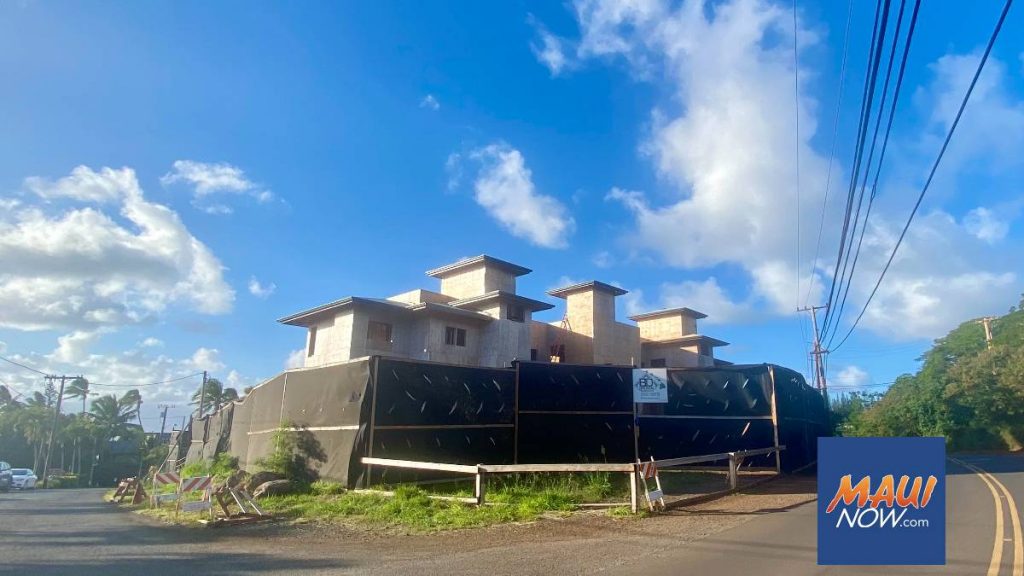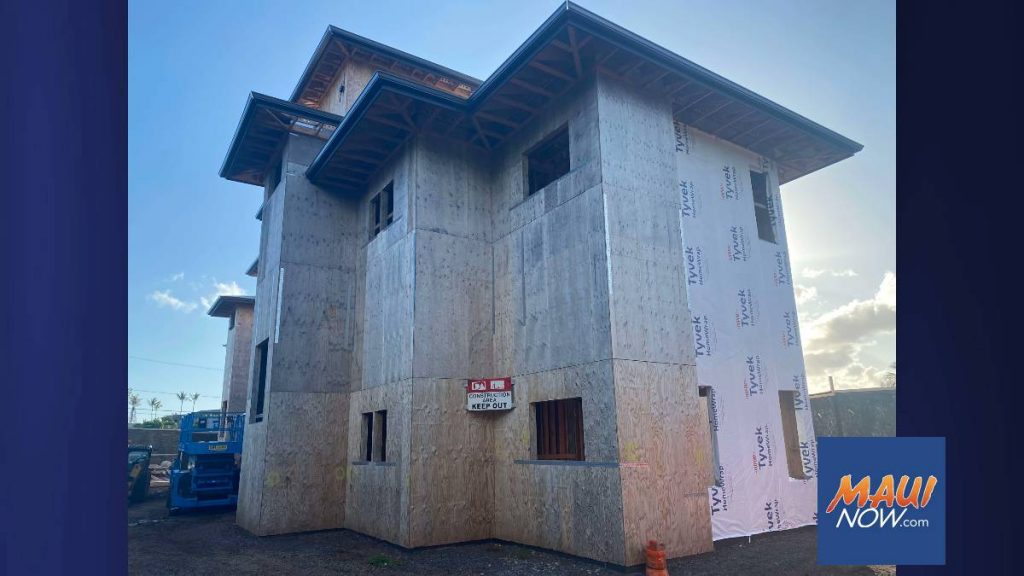Council mulls whether massive Nāpili home warrants probe; pending suit filed against Maui County



Maui County Council is considering whether to pursue an investigation into the administration’s handling of a large home in Nāpili, which has been called “monstrous” and “illegal” by neighboring residents.
Meanwhile, county lawyers confirmed Tuesday that there is at least one pending lawsuit against Maui County related to the matter.
The unfinished, eight-bedroom home came under fire last year when it climbed toward 45 feet tall. Some residents have been questioning how the county signed off on the plans without community input.
However, owner and developer Greg Brown has maintained that his 5385 Lower Honoapiʻilani Road home is in compliance with county rules. His lawyer, Jeffrey Ueoka, on Thursday said that Brown welcomes any investigations.
“He’s always represented that he’s followed the rules,” Ueoka told Maui Now. “He got everything permitted.”
County administrative leaders have echoed that staff followed rules and nothing illegal occurred.
Due to outdated county zoning code, buildings in the Nāpili district were allowed to be two stories tall — but no height was specified. Brown’s structure triggered fast legislation last year that now prevents future area buildings from being more than 30 feet in height.
Still, the county’s height clarifying move didn’t satisfy some residents of the Nāpili Bay Community Association, who at council’s Government Relations, Ethics and Transparency committee meeting March 15 threatened to sue Maui County.
“What we’ve been put in the position of is having to use our own resources and time to gather and organize and now prepare suit against the developer and unfortunately against the county,” Nāpili resident Joshua Downer of the association said.
On the association website, which seeks donations, an open letter calls the house “monstrous,” “illegal” and “a blight.”
Chairman Mike Molina during Tuesday’s Government Relations, Ethics and Transparency meeting said the panel is “wrestling” with whether permits or approvals were part of an unintentional error in the process — or, as some community members allege, that inappropriate or unlawful actions occurred.
Further, council members may decide whether a deeper investigation is needed. A council investigation is permissible under the charter, or allegations submitted to the Board of Ethics could trigger an investigation, county legal officials said Tuesday.
Council members said that project opponents may submit any facts they have directly to the board.
Nāpili resident Junya Nakoa, who has been following the issue since early 2021 and was designated a resource at Tuesday’s meeting, said he will file a complaint.
“Get ready because I going get choke fricking facts,” he said.
West Maui Council Member Tamara Paltin, who has worked closely on the issue since it was raised and introduced the legislation that makes sure it doesn’t happen again, has repeatedly asked testifiers for “evidence of intentional or criminal wrongdoing.”
Unless hard evidence is brought to light via proper channels, it won’t accomplish what people are seeking, she said.
“We will be satisfied with nothing less than its complete deconstruction or demolition,” the Nāpili Bay Community Association states online.
Short of county condemnation or acquisition, laws protect developments on private land from being razed.
Two county administrative departments oversee much of the permitting and approvals required for construction: Planning and Public Works. Both department heads have said their staff have followed rules in the Brown development.
“I don’t think any of us here understand the process,” Patlin said Tuesday. “We don’t work for Planning and we don’t work for Public Works and we don’t understand the interaction between them. If we don’t propose legislative solutions (to the building process), it makes no sense to berate the directors.”
Public Works in December issued a Stop Work Order on the home, saying that permitting and zoning rules were violated by exceeding square footage and height thresholds.
As with any project, developers were able to rectify the issues and work then resumed, according to Jordan Molina, acting Public Works director, and Michele McLean, Planning director, at Tuesday’s meeting.
Because the project is under the old height rules, gauged by stories, the developer had to remove two levels that were considered additional floors to bring it to two stories total. Also, interior space was changed to remove usable square footage. From the outside, the building looks much the same, McLean said.
All along, community members have said the developer is building a hotel disguised as a single-family home.
The project in 2019 gained a Special Management Area permit exemption, which does not involve a public notice or a public hearing like a major SMA would, based on written intent that it would be used as a single-family home, the Planning Department said last year.
In a June 25, 2021, letter to council, Brown said he had intended to use it as a short-term rental.
“I agree with many members of the community; I went out there and it sticks out like a sore thumb,” Molina said Tuesday. “I’m just very disappointed there was no communication from the builder to the community members to see how they feel.”
“If a structure like that occurred in my neighborhood, I would be disappointed as well,” he added.
Molina deferred the Nāpili house item Tuesday; it will be taken up again in May. A letter of questions by Paltin will be sent to the Board of Ethics for review. Also, Molina said related departments will be asked to report any information on allegations thus far.
At the next meeting, members will have a clearer direction on which path to take, Molina added.
“I just wanted to request that if the council does move forward with some type of investigation, whether it’s the council or the Board of Ethics or whomever, that if and the result of the investigation is that there is no wrongdoing, that you would accept the finding,” McLean said. “That’s just my request.”










